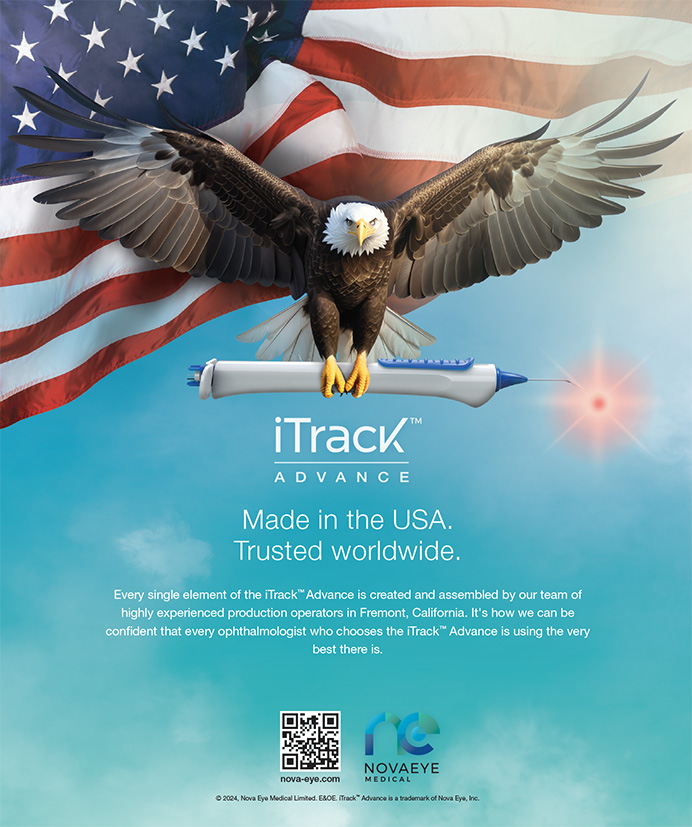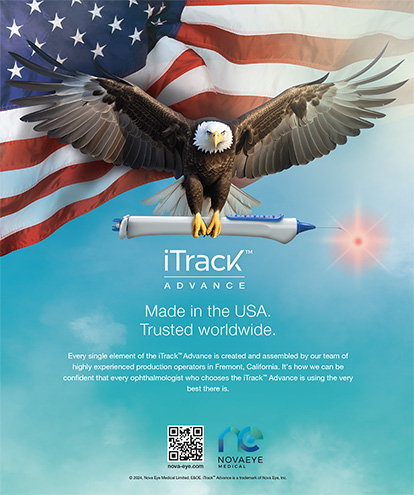| Dr. Osher's article on the complications of new technology is timely in that he will have the well-deserved honor of delivering the prestigious Innovator's Lecture at the 2009 ASCRS Symposium on Cataract, IOL and Refractive Surgery. |
| —David F. Chang, MD, Chief Medical Editor |
In reviewing my worst cataract cases, I was surprised to find more disappointing results than I expected. Even more surprising was that these cases shared something in common, which I found very revealing. Hence, I will present a series of cases rather than one isolated disaster.
HYPEROPIC CLEAR LENSECTOMY
In 1985, I had an interesting idea to perform a clear hyperopic lensectomy on an 11.00 D chemist with contact lens intolerance. He seemed very similar to the multitude of aphakes in whom I was implanting secondary IOLs. His surgery went very well, but he was left with 4.00 D of hyperopia! He was far more happy about this result than I. Some years later, I imported a completely new IOL design, a diffractive 50.00 D IOL designed for nanophthalmos by Acri.Tec, a small company in Berlin, Germany. I had never believed that tiny eyes would tolerate multiple lenses over the long run, which led to my search for a better alternative. Again, the surgery went smoothly, but I was disappointed when the patient developed a 6.00 D myopic surprise. For a refractive cataract surgeon, these results were devastating.
LOOSE ZONULES
In the late 1980s, I had listened to Okihara Nishi, MD, in Japan describing his positive experience sewing through the capsular bag. I was intrigued by the idea of refixating the capsular bag to the sclera in patients with Marfan's syndrome. Unfortunately, the capsular bag of my first patient split in half as the needle was passed and I had to resort to the standard approach of removing everything and then implanting an ACIOL. Some years later, however, I was able to achieve a better result by placing one haptic in the loose bag and passing the needle of a suture attached to the other haptic out through the equator of the lens and anchoring it to the sclera. Eventually, Robert Cionni, MD, and I began our work with capsular tension rings in 1993, and I was able to create "synthetic zonules" by suturing the ring to the ciliary sulcus. This idea became obsolete when Dr. Cionni developed the innovative eyelet on his modified capsular tension ring.
ANIRIDIA
One of my worst results occurred in 1996, shortly after I had observed Kenneth Rosenthal, MD, present the first American case of a prosthetic iris at the Welsh Cataract Congress. Intrigued by this novel approach, I immediately scheduled a series of aniridic patients for surgery but then was horrified when an innovative but brittle Morcher 50C ring (Morcher GmbH; Stuttgart, Germany) fractured during the insertion process. After this one case, I pleaded with the company to develop a flexible prosthetic iris device with color options but to no avail. Later, I encountered aniridic cases in which the anterior capsule inexplicably ruptured, which made the implantation of a prosthetic iris device impossible. Scanning electron microscopy revealed that these anterior capsules were not the typical 14 to 20 ?m in thickness but rather only 3 to 6 ?m in thickness. Perhaps the most frightening moment that I experienced with artificial irides involved a patient referred from New York with a chronic iritis secondary to an illegal phakic IOL that had resulted in severe iris prolapse. The surgeon had excised several clock hours of iris, and subsequently the patient developed a cataract. After gently removing his phakic IOL and cataract, then implanting a prosthetic iris device into the bag, I attempted to close the iris pillars for cosmesis. Just as the final McCannel suture was being tied, a loop of Prolene (Ethicon Inc., Somerville, NJ) became snagged around the tying platform. Upon withdrawing the forceps, nearly the entire iris was suddenly avulsed (Figure 1). After several moments of experiencing asystole, I began a painstaking iris reconstruction. Eventually the hyphema cleared, and the cystoid macular edema resolved, leaving the patient with a satisfactory result.
MATURE BRUNESCENT CATARACT
I had always believed that a planned extracapsular cataract extraction was a lousy operation for a mature brunescent nucleus, and an early publication by Wade Faulkner, MD, convinced me that the high incidence of unplanned intracaps was unacceptable. Therefore, in the mid-1980s I began a study emulsifying mature cataracts, which challenged one of the original five contraindications to phacoemulsification listed by Charles Kelman, MD, himself. The initial results in five cases were awful, with three torn capsules and an average cell loss of 51! When I presented these cases, I was called negligent and dangerous by my critics. However, at about this time, I modified the phaco machine with United Surgical, a small Italian company, and developed the slow motion phaco technique with surgeon-controlled lower parameters. When combined with viscosurgery, the results of emulsifying the mature cataract became much better than a planned extracapsular technique.
OCULAR CICATRICIAL PEMPHIGOID
Perhaps my most tragic case was an elderly patient with ocular cicatricial pemphigoid who had lost his first eye to a massive fibrotic reaction following uneventful cataract surgery. The patient was referred to Cincinnati for me to remove the 20/200 cataract in the fellow eye. I worked closely with Stephen Foster, MD, at Harvard who immunosuppressed the patient for 6 months. The year was 1990, and I thought a novel approach would be to perform a clear corneal incision using a "no touch" technique for conjunctiva. The standard scleral tunnel incision with subconjunctival antibiotics at the conclusion of surgery was avoided. The patient had a wonderful result for 1 week before developing a blinding Streptococcus viridans infection, my only patient with endophthalmitis in 30 years!
THERMAL INJURY
The thermal injury is a frightening event, and I have seen several incision burns during my career. In one patient, I was using a new (at the time) viscoadaptive agent, Healon5 (now available from Advanced Medical Optics, Inc. [Santa Ana, CA]), which I was evaluating for Pharmacia in Sweden. I tried to use the same low phaco parameters that had been so successful with my slow motion phaco technique. However, the more viscous material caused an obstruction at the tip, and an awful gape (Figure 2) occurred within several seconds of initiating the emulsification. I was able to close this gape with a trapezoidal suture, a technique that I subsequently published. Four years later, Healon5 was approved by the FDA and has remained my ocular viscoadaptive agent of choice.
I encountered a second gape shortly after I had observed a famous European surgeon perform one of the first cases of microincisional cataract surgery. Enthusiastically, I began performing microincisional cataract surgery using a bare phaco needle through a 1.2-mm incision and a large-gauge irrigating chopper that I designed to allow more infusion. After an unexpected wound burn and some inherent problems with the fluidics of microincisional cataract surgery, I abandoned this procedure in favor of microcoaxial phaco.
NEW TECHNOLOGY
I was fortunate to have performed the first cases of microcoaxial phacoemulsification in the United States using the Ultra Sleeve (Alcon Laboratories, Inc., Fort Worth, TX), and the results were excellent. It was easier to insert the IOL through a 2.2-mm incision if I used an instrument in my left hand through the paracentesis for counter-traction while using a C cartridge within a one-handed injector controlled with my right hand. Michelle Glossip at Duckworth & Kent Ltd. (Hertfordshire, United Kingdom) was kind enough to help me develop this injector. When Alcon Laboratories, Inc., developed its smaller D cartridge, I was given one of the original prototypes. To my surprise, the lens exploded out of the cartridge and went through the posterior capsule into the vitreous. I was able to rescue the lens using Dr. Kelman's posterior-assisted levitation technique and capture the optic anterior to the intact capsulorhexis. While I am strongly in favor of smaller incisions, I learned that there is a critical relationship between incision size, cartridge size, injector style, and kinetic energy. Surgeons using the D cartridge should utilize the two-handed Monarch insertion system (Alcon Laboratories, Inc.) rather than a one-handed injector.
NEW DRUG DELIVERY
I could not have been more enthusiastic about the concept of intracameral antibiotics, and I have predicted the demise of topicals for many years. A collaborative study designed by Stephen Lane, MD; Samuel Masket, MD; and me evaluated the intracameral injection of Vigamox (Alcon Laboratories, Inc.) at the conclusion of the case.1 I was morose when two of my patients developed toxic anterior segment syndrome, which I initially and erroneously attributed to the antibiotic. Actually, the intracameral Vigamox turned out to be extremely safe, but these two patients had coincidentally undergone surgery during a toxic anterior segment syndrome epidemic, which occurred in a brand new surgery center.
CONCLUSION
By now, the astute reader has figured out what these cases share in common. It can be summarized by one of my favorite maxims: "When you are on the cutting edge … prepare to be cut!" For many years, I have gone to the laboratory and practiced a new technique or worked with a new device before going "live" in the OR. Even thorough preparation and the best intentions may not prevent an unexpected poor result. While I continue to ache whenever I think about these patients, I do not regret exploring new techniques and novel devices. Overall, I believe that patients—those of other surgeons as well as my own—have benefited from these efforts.
Robert H. Osher, MD, is Medical Director Emeritus at the Cincinnati Eye Institute and is a professor at the University of Cincinnati College of Medicine Department of Ophthalmology. He is a paid consultant to Advanced Medical Optics, Inc., and Alcon Laboratories, Inc. Dr. Osher may be reached at (513) 984-5133 ext. 3239; rhosher@cincinnatieye.com.


